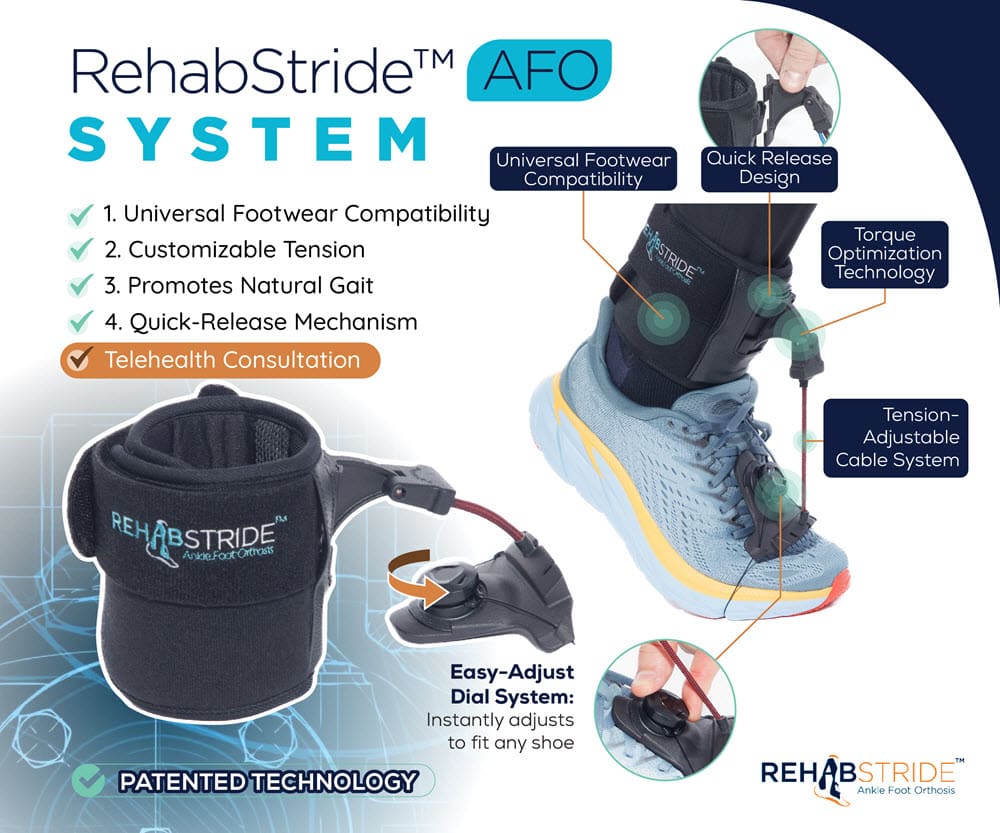By Gene Shenker, DPT
With the wide variety of braces available, choosing the right drop foot brace requires a thorough and methodical evaluation of the patient’s condition, ideally conducted by a qualified medical professional. Unfortunately, many healthcare providers may not be familiar with the most effective AFO solutions and often recommend the most basic options. Selecting the correct Ankle Foot Orthosis (AFO) brace requires careful consideration of both the subjective reports and the objective presentation of an individual’s impairment. To make an informed choice, it’s crucial to first understand the sequence of movements impacted by foot drop.
Understanding the Mechanics and Drop Foot Brace Evaluation.
In a typical gait cycle on the affected side, mid-stance is followed by a push-off where the calf muscles propel the body forward. After this push-off, the hip swings forward, leading to knee extension, and finally, the ankle should spring upward towards the shin. However, during this phase, known as the Swing Phase, the muscle responsible for this upward movement—the tibialis anterior—is often too weak in those with foot drop. This weakness leads to tripping or compensatory movements, which we will discuss further in the section titled “Compensations Resulting from Foot Drop.”

Evaluating the Need for an AFO Brace
Determining the appropriate type of AFO requires a thorough evaluation, addressing the following key questions:
- Degree of Foot Drop: Is the drop complete or partial? If partial, to what degree is it affecting the foot?
- Range of Motion: What is the difference between the Active Range of Motion (AROM) and Passive Range of Motion (PROM)?
- Calf Muscle Tightness: How tight is the calf muscle, and how much does it resist dorsiflexion?
- Patient Stability: How steady is the patient, and what functional or balance-related comorbidities exist?
The answers to these questions will guide the decision-making process. Here are a few common scenarios:
- Complete Foot Drop: When the ankle is unable to clear the toes, an AFO is essential to prevent falls and facilitate recovery.
- Minimal Partial Foot Drop: If the patient can safely swing the foot through, an AFO may not be necessary. However, it is strongly recommended to follow up with a physical therapist or adhere to a customized home exercise program. In some cases, high-ankle shoes, which immobilize the ankle in a neutral position, may suffice.
Choosing the Right AFO Brace
Once the need for an AFO is established, the next step is selecting a brace that best supports functional recovery.
- Rigid AFOs: These braces are often more affordable and primarily serve to lock the ankle at a 90-degree angle. However, they are bulky, heavy, and restrict natural ankle movement, particularly the downward push-off motion.
Dynamic AFOs: While dynamic AFOs are designed with the intention of promoting movement, most fall short in delivering the necessary torque to lift the ankle or tend to overshoot, keeping the ankle locked in dorsiflexion like a rigid AFO. The main issue lies in their lack of torque-friendly design and adjustable tension.
The RehabStride™ AFO Solution

RehabStride™ AFO was meticulously engineered to address the limitations of traditional dynamic braces. Unlike others, it caters to the unique needs of the individual rather than adopting a one-fits-all approach. The RehabStride™ AFO offers:
- Custom Torque Design: This allows for effective upward ankle movement without compromising stability or comfort.
- Tension Adjustability: This feature ensures that the brace adapts to the patient’s specific degree of weakness, providing optimal support and movement.
To elevate the AFO experience, RehabStride™ offers a Free Telehealth Evaluation and Free Onboarding with licensed clinicians. For patients who may benefit from foot drop-specific rehabilitation, RehabStride™ also provides a comprehensive rehabilitation package with program-credentialed physical therapists.
Explore the RehabStride™ AFO or Contact Us for Your Free Evaluation Today.
Related posts:
- Ankle Foot Orthosis Demystified: Choosing the Right Brace for You
- How an AFO Brace Transforms Foot Drop Exercises into Effective Treatment
- The Walking Revolution: AFO Braces and Their Transformative Effects on Mobility
- Taking Strides Towards Recovery: How AFO Brace Aids in Foot Drop Healing
- Step Into the Future: Discover the Power of RehabStride AFO Brace for Foot Drop Recovery
